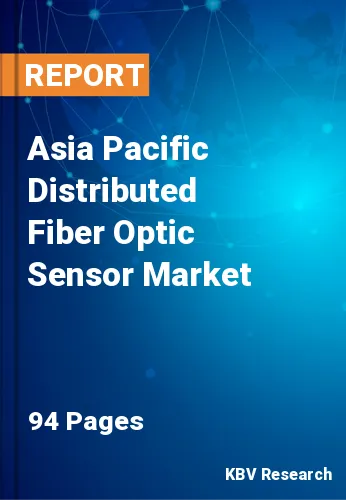The Asia Pacific Distributed Fiber Optic Sensor Market would witness market growth of 8.6% CAGR during the forecast period (2021-2027).
Distributed fiber optic sensing systems utilize the fiber optic cables & interrogator unit. These interrogator units transfer a pulse of light into the fiber optic. This pulse of light transmits into the fiber optic, and the strain events into the fiber optic are decided by backscattered light. Additionally, a huge volume of data is generated by distributed fiber optics sensing systems, and it is important to manage, process, and visualize this data. Mostly, the interrogation units are embedded to a processing unit that further organizes the data storage & processing. Most of the distributed sensing systems are built on a principle called Coherent Optical Time-Domain Reflectometer (COTDR). OTDR tracks the place of a catastrophic fiber event deciding the distance to the break.
The technology that allows constant and real-time evaluation with the complete length of a fiber optic cable is known as distributed fiber optic sensing. In comparison to conventional sensing that utilizes distinct sensors at pre-ordained points, distributed fiber optic sensing does not depend on the manufactured sensors; however, it utilizes constant optical fiber. Before the launch of distributed fiber optic sensors, it was difficult to calculate the internal stress & strain of huge structures. In the current situation, distributed fiber optic sensors help in the measurement of the internal properties of these structures. Therefore, governments of several nations around the world are highly willing to adopt these fiber optic sensors in numerous construction projects.
The high adoption rate of these sensors in the structured & building areas is creating demand for the distributed fiber optic sensor in this region. The developing phase of transportation foundation in emerging nations such as China and India would lead to the crucial development of distributed fiber optic sensor technology in the Asia Pacific region.
The growing requirement for comprehensive information-driven options in companies such as force & utility, structural designing, and others are opening lucrative growth opportunities for the key players of distributed fiber optic sensor market. In addition, various key market players are entering this region to acquire a majority of shares in the regional market.
The China market dominated the Asia Pacific Brillouin Scattering Distributed Fiber Optic Sensor Market by Country 2020, thereby, achieving a market value of $29.9 million by 2027. The Japan market is showcasing a CAGR of 8.8% during (2021 - 2027). Additionally, The India market is anticipated to witness a CAGR of 10.1% during (2021 - 2027).
Based on Technology, the market is segmented into Raman Effect, Brillouin Scattering, Rayleigh Effect, Interferometric, and Others. Based on Application, the market is segmented into Temperature Sensing, Acoustic/Vibration Sensing and Others. Based on End User, the market is segmented into Oil & Gas, Power & Utility, Safety & Security, Industrial, Civil Engineering and Others. Based on countries, the market is segmented into China, Japan, India, South Korea, Singapore, Malaysia, and Rest of Asia Pacific.
Free Valuable Insights: The Worldwide Distributed Fiber Optic Sensor Market is Projected to reach USD 1.9 Billion by 2027, at a CAGR of 8.5%
The market research report covers the analysis of key stake holders of the market. Key companies profiled in the report include of Fujikura Ltd., Furukawa Electric Co., Ltd., Bandweaver Technologies Ltd., Yokogawa Electric Corporation, Halliburton Company, Schlumberger N.V., Weatherford International PLC, Luna Innovations, Incorporated, Omnisens SA, and Terna SpA (BruggKabel AG).
By Technology
By Application
By End User
By Country
Our team of dedicated experts can provide you with attractive expansion opportunities for your business.

